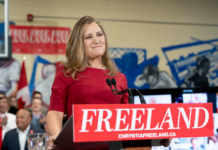The Alberta government said that this time will be different.
Plans for province-wide commuter rails have been floated by governments of varying stripes for decades but have ultimately failed to come to fruition.
That’s set to change, as the Alberta government announced its Passenger Rail Master Plan on Monday.
The previous projects may have failed because they stood on their own, but this time, Alberta is taking a holistic approach, said Alberta’s Minister of Transportation, Devin Dreeshen.
Alberta’s six-part vision for its passenger rail system encompasses a blend of public, private, and hybrid rail services designed to transform regional connectivity.
The plan includes commuter rail systems connecting the Calgary and Edmonton areas to their respective downtowns and international airports, regional rail lines linking both cities to the Rocky Mountain parks and each other with a stop in Red Deer, and municipal-led Light Rail Transit systems in Calgary and Edmonton that integrate seamlessly with the provincial network.
Additionally, strategically placed rail hubs in major cities will facilitate connections between commuter, regional, and municipal transit systems, enhancing overall mobility across Alberta.
The Alberta government will consider the feasibility of implementing hydrogen-powered trains.
“That’s why we’ve separated it into six different projects; some of them are feasible right now. Some may be more feasible in a few years from now, and some may be feasible further out,” said Alberta Premier Danielle Smith.
The premier said that Alberta’s population grew last year the most it had since 1981, by more than 202,000 people. She added that while the newcomers are a blessing, additional newcomers equate to mobility challenges, with congestions on busy roads and highways.
“Unlike federal Environment Minister Steven Guilbeault, we are willing to invest in those roads as well,” added Smith.
However, she said that expanding every highway to six, eight, or ten lanes may not be feasible or wise. A cost-benefit analysis will be done to identify which elements of a passenger rail system should proceed and when.
The Alberta government will introduce a provincial crown corporation, similar to the Metrolinx in Ontario. This crown corporation is intended to withstand the test of time, including changing governments. It will develop the infrastructure and oversee daily operations such as fare collection, system maintenance, and future system expansion planning.
“We’re also very open to having the private sector collaborate with us so that we can build out certain parts of the line without it being 100% on the public sector’s tax dollar,” said Smith.
“Nothing about this plan is going to be unilateral. It will take shape only after consultations with municipalities, industry, indigenous communities, and all Albertans interested in the future of passenger rail,” she added.
The Passenger Rail Master Plan aims to be completed by Summer 2025. Before this completion date, studies and stakeholder forums will be held to inform the final plan.
$9 million from Budget 2024 have been allocated towards the first stage. The Alberta government has earmarked $43 million in new funding to support Calgary’s Blue Line LRT expansion towards the airport. This is in addition to the province’s ongoing commitment of $3 billion to support the LRT expansions in both Calgary and Edmonton.
A comprehensive feasibility assessment identifying the passenger rail system elements will be conducted. Financial and delivery model options, including private, public, or hybrid services, will be explored. This includes assessing options to ensure the effective governance and operations of the passenger rail system.
A 15-year delivery plan with options and recommendations to the government will be presented, aiming to see the projects completed by 2040.





















